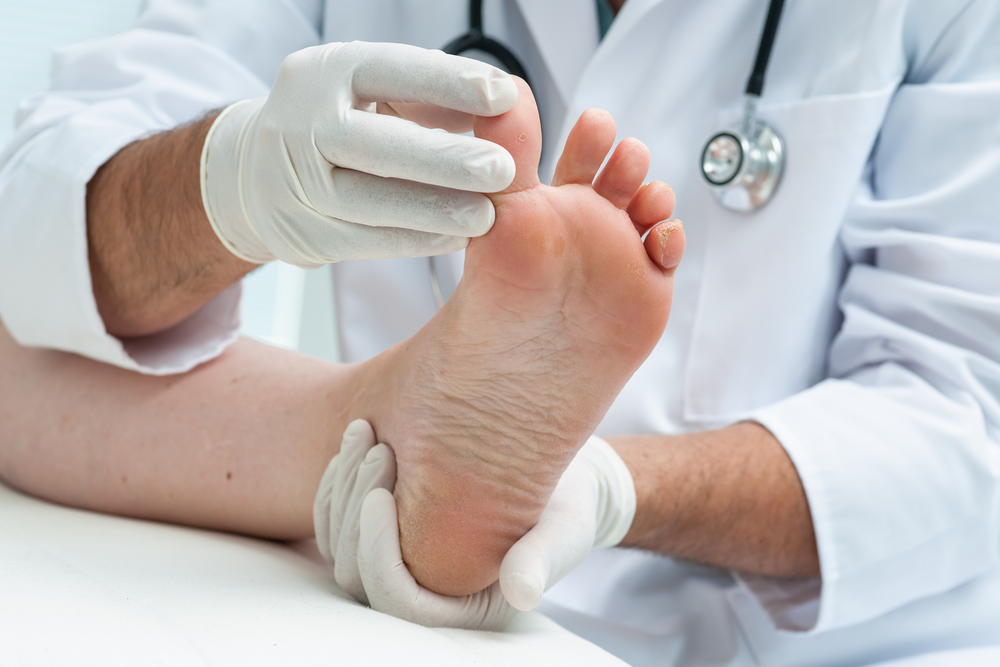The itching, burning, and stinging symptoms of athlete’s foot can be so aggravating that you almost wish you didn’t have feet at all. While this foot condition can often be successfully treated with over-the-counter medications, if it gets severe enough, you may need to get a podiatrist like those at Island Foot Clinics involved to ensure your case is eradicated.
How Can Your Doctor Help Get Rid of Athlete’s Foot?
When to See a Doctor
As mentioned above, most cases of this foot rash can be treated with over-the-counter antifungal medications. Usually, this medication is in the form of a topical cream and will need to be used as directed for probably about two week. However, if your feet do not clear up within the first seven days of using an over-the-counter antifungal cream, or it seems to be getting worse, you need to get one of our expert podiatrists involved with your treatment.
How Our Podiatrists Can Help
First, we’ll need to confirm that you do indeed have athlete’s foot and not another type of skin condition, which could be why it’s not responding well to an antifungal. We will take a scrape of skin from the part of the foot that is covered with the rash to rule out conditions like eczema, psoriasis, or cellulitis, among other similar-looking conditions. These rashes are typically bacterial in nature, which explains why an antifungal would not be an effective treatment.
Once the condition is confirmed as having a fungal cause, we’ll determine the severity of your rash and prescribe a stronger antifungal medication. We’ll likely start with a prescription-strength antifungal cream like Nizoral or Naftifine, but if your case seems particularly stubborn or the prescription cream isn’t as effective as necessary, we’ll prescribe an oral antifungal medication such as terbinafine or Sporanox. These are just examples of prescription medications available. We will carefully assess your needs before providing a prescription.
Causes
The sole cause of this foot condition is a fungus that makes its way into the body through an opening in the top layer of the skin. This opening can be a crack or wound, but to grow, the environment must be moist and warm, which is why the rash is commonly found on feet. The fungus can be spread through contact with infected skin or with objects (shower floors, towels, etc.) that have been contaminated by infected skin flakes.
Athletes are at a higher risk of contracting this foot condition because they sweat a lot during their activities and they frequently share communal shower facilities. If just one athlete contracts the fungus, chances are many others will as well, particularly because the opening in the skin does not need to be large for the fungus to enter. This is the reason why the condition is colloquially known as athlete’s foot rather than its medical name, tinea pedis.
Symptoms
Typically, when the fungus first begins to grow, you’ll notice a reddish, scaly rash between your toes. This rash may burn or itch, and some sufferers may also experience blisters. Other symptoms you might see include maceration (when the skin becomes white and wrinkly as if having been immersed in water for a significant time), fissures, and occasionally, a foul, cheese-like odor, although this may be an indication that bacteria are present as well.
Quickly, though, the rash will spread to other parts of your feet, and if you’re not careful, to other parts of your body. It is a highly contagious rash, so it is important to treat it as quickly as possible, starting with an over-the-counter antifungal cream or powder. People who have suppressed immune systems or diabetes are at higher risk of contracting this condition, especially if they have an open foot wound or touch their feet with compromised hands.
Home Treatments
As already mentioned, most mild cases of this rash can be treated with over-the-counter antifungal creams or powders. Some more popular products are Lamisil AT, Lotrimin Ultra, Tinactin, and Zeasorb among others. If you prefer to treat your condition with natural remedies, recommended products include hydrogen peroxide, tea tree oil, neem oil, rubbing alcohol, garlic, sea salt baths, vinegar, and baking soda, among others. Try each remedy separately to avoid mixing products, as this could lead to adverse effects.
Prevention Tips
Keep Your Feet Dry
Fungi cannot grow in a dry environment, so ensure you thoroughly dry your feet after you bathe or shower, paying specific attention to between your toes. If possible, go barefoot to allow your feet to completely air dry before putting on socks and shoes. To keep your feet dry when wearing shoes, consider applying a foot powder or deodorant (spray or stick) to your feet before enclosing them in socks and shoes for the day.
Change Socks At Least Daily
Socks can easily pick up the fungus that causes this condition, and if they’re damp, the fungus can grow if you continue to wear the same socks for several days. If you have a cut or other skin opening on your feet, the fungus on your socks will get into your body. Putting on a clean pair of socks at least daily will prevent the fungus from growing. If your feet sweat a lot, change your socks twice a day instead.
Choose Light, Well-Ventilated Shoes
This does not mean you have to wear sandals all the time, but the shoes you do wear should be as light as possible (avoid boots if you can) and should be made of natural materials like leather or canvas, that breathe. Synthetic materials like vinyl, plastic, or rubber will not allow air to circulate around your feet and they will likely get very sweaty, creating the ideal environment for fungus to grow and thrive.
Alternate Shoes Each Day
Wearing the same shoes day after day does not allow them to dry out thoroughly between wearings. For this reason, it is recommended that you have at least two pairs of shoes that you alternate wearing so that they can properly and completely dry after you wear them for a day. Again, the reason for this is that moist shoes create the perfect conditions under which fungi grow, increasing your risk for contracting the fungus that causes this rash.
Beware of Public Places
You never know whether someone in public might have a nasty case of Athlete’s foot, which can then spread to your feet if you don’t take the necessary precautions to avoid getting it. Never go barefoot around public showers, pools, and locker rooms because these areas are breeding grounds for fungi. All it takes is one tiny opening in the skin on your feet and you’re infected. Instead, always wear waterproof sandals around these areas.
Don’t Share Shoes
This tip seems self-explanatory, but it’s common for friends and family members to share clothing, including shoes. However, this is not a good idea since if one person has an infection, it will quickly spread to the other person who borrows their shoes if they have even a minor wound on their foot. It’s better to avoid this situation entirely by not sharing shoes with anyone.
Unfortunately, this foot condition is extremely common, which is why there are plenty of over-the-counter and prescription treatments available. Most of the time, you’ll be able to take care of it yourself. However, in moderate-to-severe cases, contact our podiatrists at Island Foot Clinics in Prince George, Williams Lake, Terrace, or one of our other clinics to eradicate your rash once and for all.

